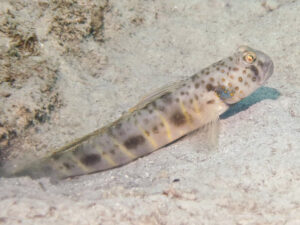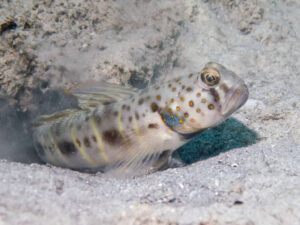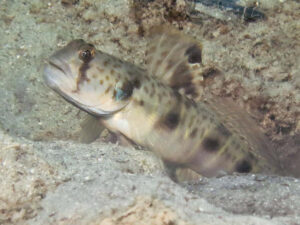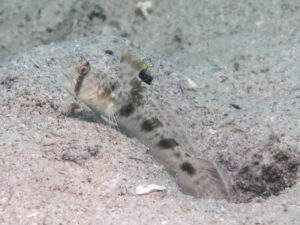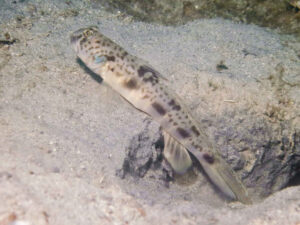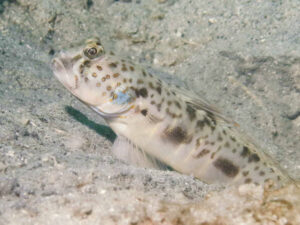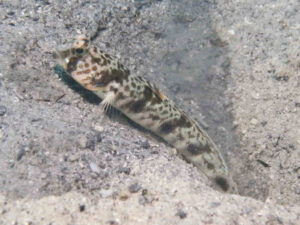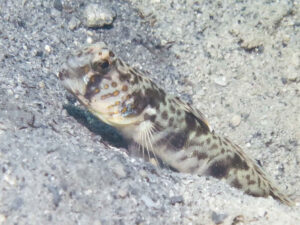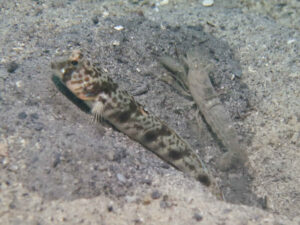Ocellated Shrimpgoby
Tomiyamichthys russus
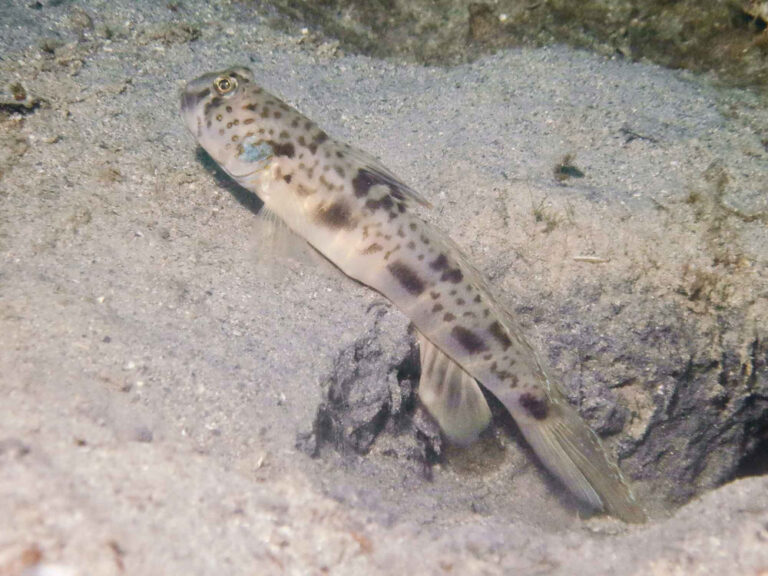
Ocellated Shrimpgoby
Tomiyamichthys russus
(Cantor, 1849)
Description
Body design
A large, up to 12 cm long, shrimpgoby living in bare silty sand in sheltered areas away from the reef.
Body design
The body is cream-coloured with five bars along its length, the first covering the gill cover and the last on the caudal peduncle. These are often reduced to paler bars with a large dark blotch mid-side. Between these are randomly arranged small dark brown spots and short squiggles that extend to the dorsum and top of the head. In mature individuals, there is a series of fine pale white to yellow bands along the side of the body overlaying the dark bars.
Head design
The markings on the side of the head consist of five diagonal rows of dark-edged yellow spots (they may be joined to form lines in younger individuals). Anterior to these there are one or two dark brown vertical lines below the eye. There is a distinctive iridescent blue patch on the gill cover.
Fin design
The first dorsal fin is roughly square, cream-coloured becoming yellow at the margin, with a white outlined black ocellated spot on the fourth dorsal spine and along the trailing edge. The pattern on the back of the fish extends onto the base of the fin. The second dorsal fin is transparent with subterminal iridescent blue lines and rows of brown spots. The pelvic fin is grey to cream-coloured. The anal fin is cream-coloured with darker bands. The caudal fin has brown and iridescent blue lines and spots. The pectoral fin is transparent with two dark spots at its base.
Diagnostic features
The diagonal lines of dark-edged yellow spots on the cheek and the ocellated spot on the first dorsal fin are reasonably conspicuous and useful features for identification.
Similar species
This fish is very similar to the recently described Smooth-scale Shrimpgoby, T levisquama but is unlikely to be confused with anything else.
T levisquama differs in having diagonal yellow spotted bands on the cheek (instead of having yellow dark-edged spots), a poorly defined dark area on the face between the eye and mouth (instead of one or two strong dark brown bars), the dorsal fin with a small spot and no white edge (instead of larger black spot with a bright white edge), a white pelvic fin with a black central portion (instead of plain white fin) and no banding on the anal fin (instead of darker banding), no blue patch on the gill cover (instead of a blue patch), no pale bands along the side of the body (instead of a series of fine pale yellow bands in mature individuals along the side of the body overlaying the dark bars).
The broad features are like several other Tomiyamichthys species. The face design, clearly defined lateral bars and the ocellated first dorsal fin distinguish this species. T. russus also lacks tubular nostrils.
Natural History
Habitat
Described from silty inshore reefs, often in stream mouths in 1 to 5 m.
In Australia, we have found this species in fine silty sand with scattered Halophilia seagrass, away from the reef or bommies at 6 to 8 metres depth.
Behaviour
This shrimpgoby, not previously recorded from Australia, is an inhabitant of a localised part of the fine sand/silt of the central portion of a mangrove island bay in the Great Barrier Reef lagoon. The habitat is shared with other silt-inhabiting shrimpgobies like Mahidolia mystacina, Amblyeleotris fontanesii and Myersina nigrivirgata. They all favour the undisturbed sand near the moorings where anchor chains do not scour the sea bed. The numbers Of T russus vary more than the other species but at times like early dry season, as the water temperature falls, they are fairly common.
The juveniles are difficult to see as they are reluctant to emerge from their burrows and rarely extend their dorsal fins and the cheek details are difficult to define in the small individuals.
Distribution
Published distribution:
Malaysia (Penang), Vietnam, Indonesia (Java Sea to the Lesser Sunda Islands), Philippines (Palawan), Papua New Guinea (New Britain) and Japan (Yaeyama Islands)
Our records (new Record)
Australia: Low Isles, Queensland.
Associated Shrimp species
Associated Shrimps (one Shrimp)
Diagonal Barred Snapping Shrimp, Alpheus rapacida


